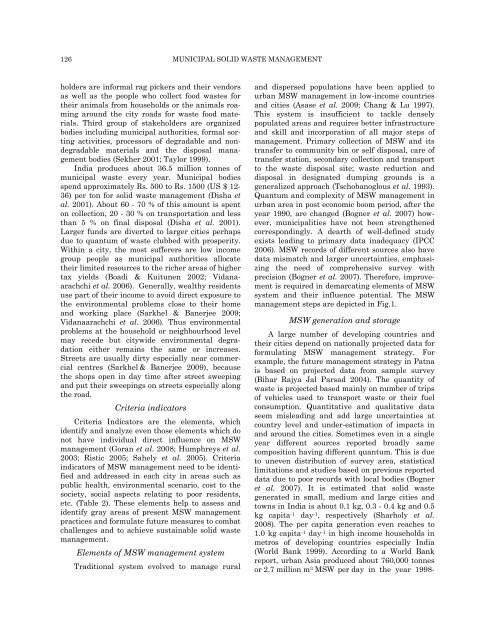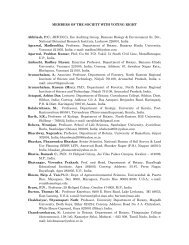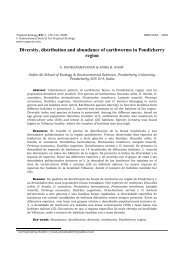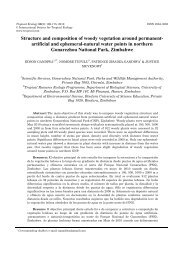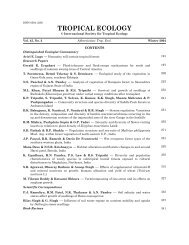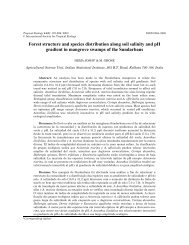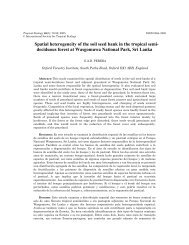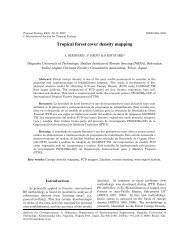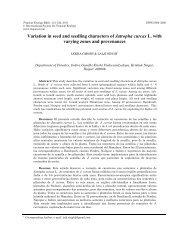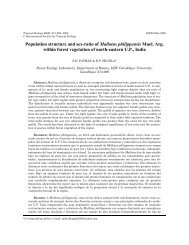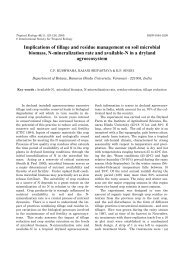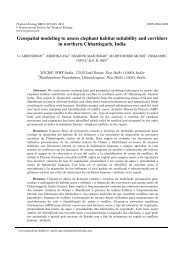Sustainable municipal solid waste management in ... - ResearchGate
Sustainable municipal solid waste management in ... - ResearchGate
Sustainable municipal solid waste management in ... - ResearchGate
You also want an ePaper? Increase the reach of your titles
YUMPU automatically turns print PDFs into web optimized ePapers that Google loves.
126 MUNICIPAL SOLID WASTE MANAGEMENT<br />
holders are <strong>in</strong>formal rag pickers and their vendors<br />
as well as the people who collect food <strong>waste</strong>s for<br />
their animals from households or the animals roam<strong>in</strong>g<br />
around the city roads for <strong>waste</strong> food materials.<br />
Third group of stakeholders are organized<br />
bodies <strong>in</strong>clud<strong>in</strong>g <strong>municipal</strong> authorities, formal sort<strong>in</strong>g<br />
activities, processors of degradable and nondegradable<br />
materials and the disposal <strong>management</strong><br />
bodies (Sekher 2001; Taylor 1999).<br />
India produces about 36.5 million tonnes of<br />
<strong>municipal</strong> <strong>waste</strong> every year. Municipal bodies<br />
spend approximately Rs. 500 to Rs. 1500 (US $ 12-<br />
36) per ton for <strong>solid</strong> <strong>waste</strong> <strong>management</strong> (Disha et<br />
al. 2001). About 60 - 70 % of this amount is spent<br />
on collection, 20 - 30 % on transportation and less<br />
than 5 % on f<strong>in</strong>al disposal (Disha et al. 2001).<br />
Larger funds are diverted to larger cities perhaps<br />
due to quantum of <strong>waste</strong> clubbed with prosperity.<br />
With<strong>in</strong> a city, the most sufferers are low <strong>in</strong>come<br />
group people as <strong>municipal</strong> authorities allocate<br />
their limited resources to the richer areas of higher<br />
tax yields (Boadi & Kuitunen 2002; Vidanaarachchi<br />
et al. 2006). Generally, wealthy residents<br />
use part of their <strong>in</strong>come to avoid direct exposure to<br />
the environmental problems close to their home<br />
and work<strong>in</strong>g place (Sarkhel & Banerjee 2009;<br />
Vidanaarachchi et al. 2006). Thus environmental<br />
problems at the household or neighbourhood level<br />
may recede but citywide environmental degradation<br />
either rema<strong>in</strong>s the same or <strong>in</strong>creases.<br />
Streets are usually dirty especially near commercial<br />
centres (Sarkhel & Banerjee 2009), because<br />
the shops open <strong>in</strong> day time after street sweep<strong>in</strong>g<br />
and put their sweep<strong>in</strong>gs on streets especially along<br />
the road.<br />
Criteria <strong>in</strong>dicators<br />
Criteria Indicators are the elements, which<br />
identify and analyze even those elements which do<br />
not have <strong>in</strong>dividual direct <strong>in</strong>fluence on MSW<br />
<strong>management</strong> (Goran et al. 2008; Humphreys et al.<br />
2003; Ristic 2005; Sahely et al. 2005). Criteria<br />
<strong>in</strong>dicators of MSW <strong>management</strong> need to be identified<br />
and addressed <strong>in</strong> each city <strong>in</strong> areas such as<br />
public health, environmental scenario, cost to the<br />
society, social aspects relat<strong>in</strong>g to poor residents,<br />
etc. (Table 2). These elements help to assess and<br />
identify gray areas of present MSW <strong>management</strong><br />
practices and formulate future measures to combat<br />
challenges and to achieve susta<strong>in</strong>able <strong>solid</strong> <strong>waste</strong><br />
<strong>management</strong>.<br />
Elements of MSW <strong>management</strong> system<br />
Traditional system evolved to manage rural<br />
and dispersed populations have been applied to<br />
urban MSW <strong>management</strong> <strong>in</strong> low-<strong>in</strong>come countries<br />
and cities (Asase et al. 2009; Chang & Lu 1997).<br />
This system is <strong>in</strong>sufficient to tackle densely<br />
populated areas and requires better <strong>in</strong>frastructure<br />
and skill and <strong>in</strong>corporation of all major steps of<br />
<strong>management</strong>. Primary collection of MSW and its<br />
transfer to community b<strong>in</strong> or self disposal, care of<br />
transfer station, secondary collection and transport<br />
to the <strong>waste</strong> disposal site; <strong>waste</strong> reduction and<br />
disposal <strong>in</strong> designated dump<strong>in</strong>g grounds is a<br />
generalized approach (Tschobanoglous et al. 1993).<br />
Quantum and complexity of MSW <strong>management</strong> <strong>in</strong><br />
urban area <strong>in</strong> post economic boom period, after the<br />
year 1990, are changed (Bogner et al. 2007) however,<br />
<strong>municipal</strong>ities have not been strengthened<br />
correspond<strong>in</strong>gly. A dearth of well-def<strong>in</strong>ed study<br />
exists lead<strong>in</strong>g to primary data <strong>in</strong>adequacy (IPCC<br />
2006). MSW records of different sources also have<br />
data mismatch and larger uncerta<strong>in</strong>ties, emphasiz<strong>in</strong>g<br />
the need of comprehensive survey with<br />
precision (Bogner et al. 2007). Therefore, improvement<br />
is required <strong>in</strong> demarcat<strong>in</strong>g elements of MSW<br />
system and their <strong>in</strong>fluence potential. The MSW<br />
<strong>management</strong> steps are depicted <strong>in</strong> Fig.1.<br />
MSW generation and storage<br />
A large number of develop<strong>in</strong>g countries and<br />
their cities depend on nationally projected data for<br />
formulat<strong>in</strong>g MSW <strong>management</strong> strategy. For<br />
example, the future <strong>management</strong> strategy <strong>in</strong> Patna<br />
is based on projected data from sample survey<br />
(Bihar Rajya Jal Parsad 2004). The quantity of<br />
<strong>waste</strong> is projected based ma<strong>in</strong>ly on number of trips<br />
of vehicles used to transport <strong>waste</strong> or their fuel<br />
consumption. Quantitative and qualitative data<br />
seem mislead<strong>in</strong>g and add large uncerta<strong>in</strong>ties at<br />
country level and under-estimation of impacts <strong>in</strong><br />
and around the cities. Sometimes even <strong>in</strong> a s<strong>in</strong>gle<br />
year different sources reported broadly same<br />
composition hav<strong>in</strong>g different quantum. This is due<br />
to uneven distribution of survey area, statistical<br />
limitations and studies based on previous reported<br />
data due to poor records with local bodies (Bogner<br />
et al. 2007). It is estimated that <strong>solid</strong> <strong>waste</strong><br />
generated <strong>in</strong> small, medium and large cities and<br />
towns <strong>in</strong> India is about 0.1 kg, 0.3 - 0.4 kg and 0.5<br />
kg capita -1 day -1 , respectively (Sharholy et al.<br />
2008). The per capita generation even reaches to<br />
1.0 kg capita -1 day -1 <strong>in</strong> high <strong>in</strong>come households <strong>in</strong><br />
metros of develop<strong>in</strong>g countries especially India<br />
(World Bank 1999). Accord<strong>in</strong>g to a World Bank<br />
report, urban Asia produced about 760,000 tonnes<br />
or 2.7 million m 3 MSW per day <strong>in</strong> the year 1998-


